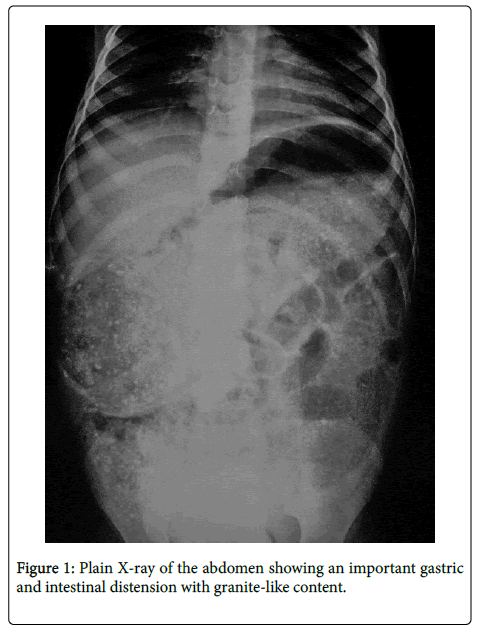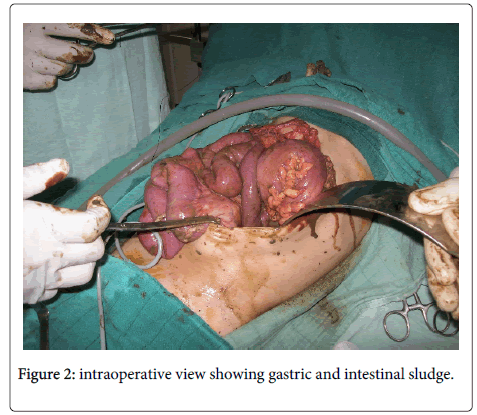Geophagy in Children: A Rare Cause of Bowel Obstruction
Received: 29-Apr-2018 / Accepted Date: 15-May-2018 / Published Date: 17-May-2018 DOI: 10.4172/2476-2024.1000140
Abstract
Geophagy is an eating disorder defined by an irresistible urge to ingest soil or clay. This cosmopolitan practice has always challenged the medical world. The aim of our work is to discuss a rare case of intestinal obstruction due to geophagy and to illustrate the role of imaging in the diagnosis and management of this condition.
A 5-year-old child presented in the emergency unit complaining from painful abdomen and bile stained vomiting during 24 h. Clinical examination revealed fever, a distended and tender abdomen, and rectal examination feels hard stools. Upright abdominal radiograph showed a significant gastric and intestinal distension with a granite-like content covering the entire digestive tract with some air-fluid levels, confirming the diagnosis of bowel obstruction. In exploratory laparotomy intraperitoneal cavity and intestinal lumen were full of soil and sludge associated to a sigmoid perforation.
Geophagy is a rare but serious cause of bowel obstruction, awareness of this problem is essential for early diagnosis and effective management. The diagnosis is based on clinical and abdominal plain X-ray.
Keywords: Geophagy; Bowel obstruction; Children; X-ray; Surgery
Introduction
Geophagy is a disorder of eating behavior defined by an irresistible urge to ingest soil or clay, its prevalence in children is unknown, it is often associated with mental retardation. It can be the cause of serious surgical complications [1,2]. The aim of this work is to discuss a rare case of intestinal obstruction due to geophagy as well as to illustrate the role of imaging in the diagnosis and management of this condition.
Case Presentation
A 5-year-old child presented in the emergency unit complaining from painful abdomen and bile stained vomiting during 24 h. Clinical examination revealed fever of 38°, a distended and tender abdomen, and rectal examination feels hard stools. The grandmother alone that day did not provide us with additional elements to explain the individualized aspect on the upright abdominal radiograph (Figure 1), which it showed a significant gastric and intestinal distension with a granite-like content covering the entire digestive tract with some airfluid levels, confirming with the result of the clinical examination the diagnosis of bowel obstruction.
The urgent clinical condition of the patient and the patterns of acute abdomen prompted the emergent laparotomy to be carried on. In exploratory laparotomy intraperitoneal cavity and intestinal lumen were full of soil and sludge associated to a sigmoid perforation (Figure 2). The resumption of history taking with the mother, revealed a notion of geophagy in the child, and finally the diagnosis was bowel obstruction on geophagy.
Discussion
Geophagia is an eating disorder defined by an irresistible urge to ingest soil or clay [1]. This cosmopolitan practice has always challenged the medical world. It is of particular concern to pediatricians and obstetricians. It was reported as early as 40 B.C. in children and pregnant women, reported in medical books since 1563 and frequently observed in the southern United States in the 1800s [2].
The prevalence of a practice that was as stigmatized as geophagy is hardly appreciable. We do not have an epidemiological study in the general population, but only estimates in pregnant women, young children or patients with psychiatric disorders.
The numbers are very different on small samples from at risk populations: 80% of geophages among 406 children attending school in Zambia, 27% among 270 pregnant women in Iran, 70% among iron deficient in Kenya, 21% of pica in adults with psychiatric disorders [3-5].
Apart from the ingestion of metal ions whose toxicity poses real public health problems, the possibility of infection with serious parasitic and microbial agents, a deficiency of iron which occurs at medium term, and severe mechanical complications of geophagy were reported [3,6,7]. They occur when the quantities ingested exceed the capacity of hydration of the digestive tract [8]. They go from major constipation, to bowel obstruction and even digestive perforation as in the reported case.
Some cases of bowel obstruction secondary to geophagy in children were reported in the literature, age limits ranged from 5 years (our study) to 14 years for the3 study conducted by D.Yé, the majority of patients were male [9-13].
This disorder may be associated with mental retardation which was reported in many studies, including ours where psychomotor retardation is found [9,12,13]. Clinically, abdominal pain and vomiting were the most frequently encountered signs, the clinical examination in our patient found a distended and tender abdomen, digital rectal examination found a fingerstall soiled with sand, this clinical features are similar to that found in the cases reported by D.Yé [12] and J. Gulia [13].
The abdominal plain X-ray in our patient found a significant gastric distension with individualization of a granite-like content throughout the digestive tract which reflects the massive amount ingested by our patient (Figure 1). According to R. Clayton, complete opacification of the entire digestive tract is a rare occurrence and would not pose a diagnostic problem [14]. The amount of sand ingested on average is much smaller than that found in our patient. Radiological signs can easily be missed if they are not specifically sought. The chances of detection of soil in the stomach are higher if early pictures are made.
IN the small intestine the sand is much less visible because of its dilution by the large volume of intestinal fluid. Optimal opacification occurs in the colon because of the high absorption of water at this level. The contrast can be significantly improved by using low penetration films due to the high average absorption coefficient of the clay [15]. The detection of opaque foreign bodies in the digestive tract, although a good diagnostic criterion in the immediate, does not provide a reliable clue as to the habit of geophagy or the chronicity of the condition.
Different non-invasive treatments were reported in the literature based primarily on manual extraction, enemas, and laxatives that give good results in general, but failure should suggest surgical treatment [13,14]. Occurrence of geophagy occlusion in children should always discuss other underlying causes [10]. The ileocecal topography may be related to the existence of an ileocecal valve which narrows this area, and impede colic progression. Ulceration and necrosis may still occur, thus life threatening the patient and indicating emergency surgery. Conservative treatment is possible, but surgery remains the prerogative of complicated forms.
Conclusion
Geophagy is a rare but serious cause of bowel obstruction, awareness of this problem is essential for early diagnosis and effective management. The diagnosis is based on clinical and abdominal plain X-ray.
Competing Interests
The authors declare no competing interest.
Authors Contributions
• Ayoub El Hajjami: Junior Radiologist, main author
• Dounia basraoui: Senior Radiologist
• Mohamed ouledSaiad: Surgeon
• Hicham Jalal: Senior Radiologist
References
- Lambert V, Boukhari R, Misslin-Tritsch C, Carles G (2013) La géophagie: Avancées dans la compréhension de ses causes et conséquences. Rev Med Interne 34: 94-98.
- Rose EA, Porcerelli JH (2000) Pica: Common but commonly missed. J Am Borad Fam Pract 13: 353-358.
- Njiru H, Elchalal U (2011) Geophagy during pregnancy in Africa: a literature review. Obs Gynecol Surv 66: 452-459.
- Kettaneh A, Eclache V, Fain O, Sontag C, Uzan M, et al. (2005) Pica and food craving in patients with iron-deficiency anemia: a case-control study in France. Am J Med. 118: 185-188.
- Horner RD, Lackey CJ, Kolasa K (1991) Pica practices of pregnant women. J Am Diet Assoc 91: 34-38.
- Couloures K (2011) Prenatal lead poisoning due to maternal exposure results in developmental delay. Pediatr Int 53: 242-244.
- Laclotte C, Oussalah A, Rey P, Bensenane M, Pluvinage N, et al. (2008) Helminthes et maladies inflammatoires chroniques intestinales. Gastroenterol Clin Biol 32: 1064-1074.
- Gonnot A, Gache A, Bismuth S (2009) Le pica cause ou conséquence de l’anémie ferriprive: étude de 10 cas. La Rev Méde Inter 10: 477.
- Med M, Mwambu T (2001) Sub acute intestinal obstruction by river sand. Tropl Dr 3: 23.
- Martindale JL, Bunker CJ, Noble VE (2010) A Patient with Pica. J Gastroenterol Hepatol 6: 582-584.
- Anderson JE, Akmal M (1991) Surgical complications of pica: report of a case of intestinal obstruction and a review of the literature. Am Surg 57: 663-667.
-  Yé D, Kam K, Sanou F, Traoré SS, Kambou S, et al. (2004) Occlusion intestinale et géophagie chez un garçon de 14 ans. Arch pédiatrie 460-468.
- Gulia J, Yadav S, Rattan K, Hooda A (2007) Complications of Pica: Case Report and Review of Literature. J Gastroenterol Hepatol 2: 2-5.
- Clayton R (1995) The roentgenographic diagnosis of geophagia. Am J Roentgenol 73: 203-207.
- Vessal K, Ronaghy HA, Zarabi M (1975) Radiological changes in pica. Am J Clin Nutr.;28: 1095-1098.
Citation: Elhajjami A, Basraoui D, Jalal H, Saiad MO (2018) Geophagy in Children: A Rare Cause of Bowel Obstruction. Diagn Pathol Open 3: 140. DOI: 10.4172/2476-2024.1000140
Copyright: © 2018 Elhajjami A, et al. This is an open-access article distributed under the terms of the Creative Commons Attribution License, which permits unrestricted use, distribution, and reproduction in any medium, provided the original author and source are credited.
Select your language of interest to view the total content in your interested language
Share This Article
Open Access Journals
Article Tools
Article Usage
- Total views: 7458
- [From(publication date): 0-2018 - Dec 06, 2025]
- Breakdown by view type
- HTML page views: 6492
- PDF downloads: 966


